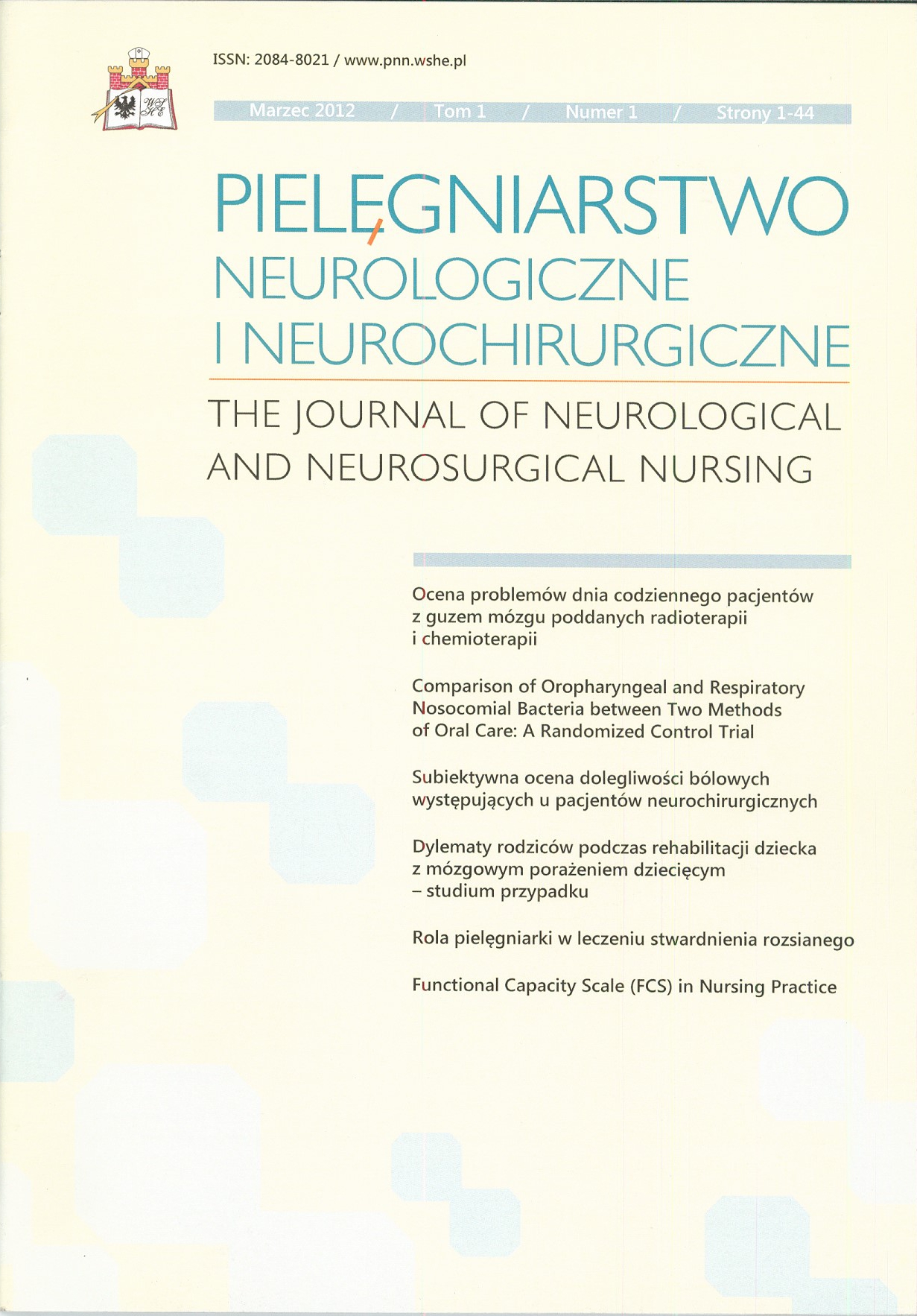The Dilemmas of Parents During the Rehabilitation of Children with Cerebral Palsy – a Case Study
Keywords
cerebral palsy, Vojta method, case studyAbstract
Background. In the first period of treatment of a child with cerebral palsy motor rehabilitation is needed. The aim of the study is to present the dilemmas of parents of children with cerebral palsy during the rehabilitation by Vojta method.
Case study. The case study concerns 15-month old boy with cerebral palsy with right-sided hemiparesis. Parents from the child’s birth observed less activity of right upper limb and many times stressed the fact that in the neonatal and early infancy period were confirmed in the belief that the child is healthy. In 10th month of age, a pediatric neurologist put a preliminary diagnosis of cerebral palsy with right-sided hemiparesis, that confirmed in the 13th months of age. The child is rehabilitated by the NDT- Bobath and Vojta method. During exercises conducted by Vojta the baby cries and screams. The child’s behavior led to eliminate the mother from the therapy. His father, despite serious doubts continued exercises. In addition, parents’ anxiety is caused by the high cost of rehabilitation conducted at home.
Discussion. Cerebral palsy includes a group of nonprogressive motor teams arise as a result of failure or brain disorder in the early stages of its developments.
Conclusions. The parents of a disabled child are faced with the need to take the decision to select the most effective methods of therapy for their child, and a source of acute stress is the responsible for the effects of the rehabilitation and the perspective of lack of funds. In cases of suspected child developmental disorders it is necessary to make a prudent diagnosis by a physician and therapists. The diagnosis of cerebral palsy is never simultaneous, and is determined by the growth of suspicion. The parents of a disabled child require a continuous assessment of demand for specialist help and therapeutic care. (PNN 2012;1(1):23-28)
References
Becher J.G. Pediatric rehabilitation in children with cerebral palsy: general management, classification of motor disorders. http.//www.oandp.org./20.02.2012.
Russman B.S., Ashwal S. Evaluation of the child with cerebral palsy. Seminars in Pediatric Neurology. 2004;11(1):47-57.
Michałowicz R. Mózgowe porażenie dziecięce. PZWL, Warszawa 2001.
Kobel-Buys K. Medyczne aspekty mózgowego porażenia dziecięcego. W: Bobera T., Kobel-Buys K. (Red.), Mózgowe porażenie dziecięce z doświadczeń trzyletniego programu rehabilitacyjnego. AWF, Wrocław 2006;9-25.
Mania M., Barczykowska E., Szrajda J. Postępowanie pielęgniarskie wobec dziecka z mózgowym porażeniem dziecięcym. W: Barczykowska E., Ślusarz R., Szewczyk M.T. (Red.), Pielęgniarstwo w pediatrii. Borgis, Warszawa 2006;29-41.
Cerebral palsy: http://www.medical-dictionary.cc/16.01.2012.
Mutch L., Alberman E., Hagberg B., Kodama K., Perat M.V. Cerebral palsy epidemiology: where are we now and where are we going? Developmental Medicine and Child Neurology. 1992;34(6):547-51.
Shevell M.I., Bodensteiner J.B. Cerebral palsy: defining the problem. Seminars in Pediatric Neurology. 2004;11(1):2-4.
Bax M., Goldstein M., Rosenbaum P., et al. Proposed definition and classification of cerebral palsy, April 2005. Developmental Medicine and Child Neurology. 2005;47(8):571-6.
Steiborn B. Wybrane zagadnienia z neurologii dziecięcej: padaczka wieku rozwojowego i mózgowe porażenie dziecięce – możliwości diagnostyczne i lecznicze. Family Medicine & Primary Care Review. 2008;10(1):107-115.
Komorska M. Sytuacja dzieci i młodzieży niepełnosprawnej w społeczeństwie polskim. UMCS, Lublin 2000.
Aly M. Dziecko specjalnej troski. GWP, Gdańsk 2002.
Czochańska J. Badanie i ocena neurorozwojowa noworodków i niemowląt. Folium, Lublin 1995.
Czochańska J. Neurologia dziecięca. PZWL, Warszawa 1998.
Rentinck I.C., Ketelaar M., Jongmans M.J., Gorter J.W. Parents of children with cerebral palsy: a review of factors related to the process of adaptation. Child: Care, Health and Development. 2007 Mar;33(2):161-169.
Twardowski A. Rodzina a dziecko niepełnosprawne. W: Obuchowska I. (Red.), Dziecko niepełnosprawne w rodzinie. WSiP, Warszawa 1999;18-27.
Kościelska M. Trudne macierzyństwo. WSiP, Warszawa 1998.
Milewska-Bobula B., Chmielnik J., Jóźwiak S. Mózgowe porażenie dziecięce. ViaMedica, Gdańsk 2003.
Rybska I., Kowalski I. M., Wiśniewska T. Analiza warunków socjalnych dziecka z mózgowym porażeniem dziecięcym. Postępy rehabilitacji. 2005;(4):39-44.
Kawczyńska-Butrym Z. Rodziny osób niepełnosprawnych. IFiSPAN, Warszawa 1994.
Chiarello L.A., Palisano R.J., Maggs J.M., et al. Family priorities for activity and participation of children and youth with cerebral palsy. Physical Therapy. 2010 Sep;90(9):1254–1264.
Ketelaar M., Volman M.J., Gorter J.W., Vermeer A. Stress in parents of children with cerebral palsy: what sources of stress are we talking about? Child: Care, Health and Development. 2008 Nov;34(6):825-829.
Palisano R.J., Almarsi N., Chiarello L.A., Orlin M.N., Bagley A., Maggs J. Family needs of parents of children and youth with cerebral palsy. Child: Care, Health and Development. 2010 Jan;36(1):85-92.
Downloads
Published
How to Cite
Issue
Section
License

This work is licensed under a Creative Commons Attribution-NoDerivatives 4.0 International License.
Stats
Number of views and downloads: 563
Number of citations: 0
